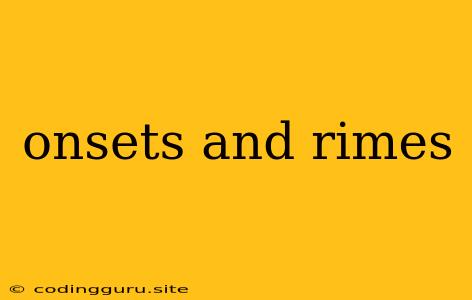Understanding the Building Blocks of Words: Onsets and Rimes
Have you ever wondered how children learn to read and spell? It's a complex process that involves understanding the sounds of language and how they are represented by letters. One important concept in this journey is the understanding of onsets and rimes.
What are onsets and rimes?
Onsets are the initial consonant sounds or consonant blends at the beginning of a syllable. Think of it as the "attack" part of a word. For example, the onset of the word "cat" is "c." In the word "train," the onset is "tr."
Rimes are the vowel sound and any following consonants in a syllable. It's the rhyming part of the word. For example, the rime in "cat" is "at." In the word "train," the rime is "ain."
Why are onsets and rimes important?
Understanding onsets and rimes helps children with:
- Decoding words: By recognizing common rimes, children can learn to decode new words. For example, if a child knows the rime "-at" in "cat," they can apply this knowledge to read other words like "hat," "mat," and "bat."
- Spelling words: Understanding onsets and rimes helps children break down words into smaller units, making it easier to spell them.
- Phonics: The concept of onsets and rimes is closely tied to phonics, which is the relationship between letters and sounds. By learning about onsets and rimes, children can develop a strong foundation in phonics.
How can you teach onsets and rimes to children?
Here are some fun and engaging ways to introduce onsets and rimes to children:
- Rhyming games: Play rhyming games like "I Spy" or "Rhyme Time." For example, say "I spy something that rhymes with 'cat.'"
- Word building: Use magnetic letters or blocks to build words, focusing on the onset and rime. You can also play a game where children build words with a specific onset or rime.
- Picture cards: Create or find picture cards with different words. Have children sort the cards by their onsets or rimes.
- Read aloud: When reading aloud, point out the onset and rime in words. You can also ask children to identify the onset and rime in the words they read.
Examples:
- Word: "Dog"
- Onset: "d"
- Rime: "og"
- Word: "Spin"
- Onset: "sp"
- Rime: "in"
- Word: "Truck"
- Onset: "tr"
- Rime: "uck"
Conclusion:
Understanding onsets and rimes is a crucial skill for children learning to read and spell. By breaking down words into smaller units, children can develop a deeper understanding of the sounds of language and how letters represent those sounds. Incorporating fun and engaging activities into learning can make the process enjoyable and effective. By focusing on onsets and rimes, you can help children develop a solid foundation for reading and spelling success!
